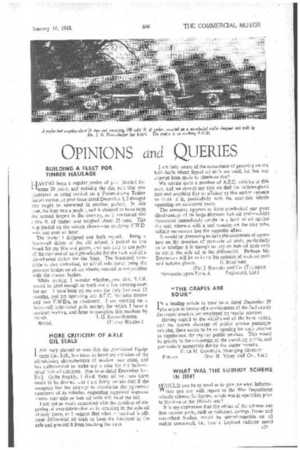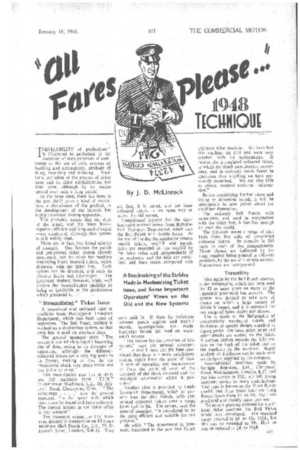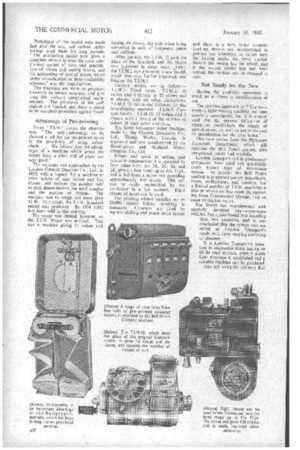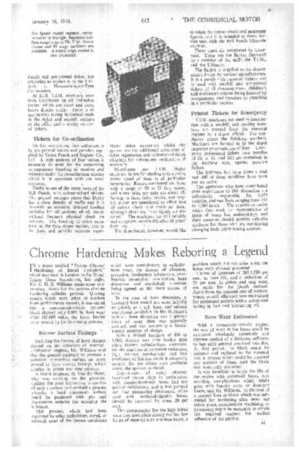OPINIONS and
Page 31

Page 32

Page 33

Page 34

Page 35

If you've noticed an error in this article please click here to report it so we can fix it.
UERIES
BUILDING A FLEET FOR TIMBER HAULAGE WAVING been a regular reader of your journal for "some 20 years, and noticing the elm butt that you illustrated as being carried on a Foden-drawn Tasker timber carrier, in your issue dated December 5, I thought you might be interested in another picture. In this case, the butt was a poplar, and is claimed to have been the second largest in the country, as it contained 690 cubic ft. of timber and weighed about 23 tons, This was loaded on the vehicle shown—an ex-Army F.W.D. —in just over an hour.
The trailer I designed and built myself. Being a Scarnmell driver of the old school, I looked to this breed for my bits and pieces, and was able to use parts of the rear end of an eight-wheeler for the back and of a six-wheeled tanker for the front. The Scammell turntable is also embodied, an added refinement being the pressure brakes on all six wheels, worked in conjunction with the tractor brakes.
While writing, I wonder whether, .one day, S.T.R. would be kind enough to work out a few running costs for me. I have been on my own for only just over 12 months, and am operating one A.E.C. Matador tractor and two F.W.D,s, as illustrated. I am working on a Scammell articulated pole carrier, for which I have a contract waiting, and hope to complete this machine by Nlarch. J. G. RIXON-BADGER Bristol. (Timber Haulier.)
MORE CRITICISM OF AXLE OIL SEALS I AM very pleased to note that the Associated Equip ment Co., Ltd., has taken to heart my criticism of the oil-retaining characteristics of modern rear axles, and has endeavoured to make out a case for the bellowsgland hub oil retainers. [See issue dated December 5.— ED.] Quite frankly, I think these oil retainers leave much to be desired, and I am fairly certain that if the company has the courage to circularize the rugnerous operators of its vehicles, requesting suggested improvements, rear axle or hub oil seals will head the list.
I am not so much concerned with the problem of disposing of over-lubrication as in retaining in the axle oil already there, so I suggest that what is required is efficient differential oil seals to keep the lubricant in the axle and prevent it from reaching the hubs. I am fully aware of the occurrence of grooving on the half-shafts where lipped oil seals are used, but has any attempt been made to eliminate this?
We service quite a number of A.E.C. vehicles in this area, and we cannot say that we Find the bellows-gland hub seal anything like as efficient as this maker appears to think it is, particularly with the near-side wheels operating on cambered roads.
The company appears to have overlooked one great disadvantage of its large-diameter hub oil seal—vehicle movement immediately results in a head of oil against the seal, whereas with a seal running on the axle tube, vehicle movement has the opposite effect.
R would be interesting to have the comments of operators on the question of rear-axle oil seals, particularly as to whether it is enough to rely on hub oil seals only to retain the axle oil in the differential. Perhaps Mr, Emmerson will let us know his opinion of such oil seals and bellows glands. E. STOTHARD (For J. Brewster and Co. (Transport Newcastle-upon-Tyne, 4 Engineers), Ltd.)
"THE GRAPES ARE SOUR" IN a leading article in your issue dated Dezember 19 'you argue in favour of a continuance of the fuel supply for motor coaches not employed on regular services.
Having regard to the withdrawal of the basic ration, and the known shortage of public service passenger vehicles, there seems to be an opening for such coaches to supplement the regular public services. This would be greatly to the advantage.of the travelling public, and particularly acceptable during the winter months.
C. LE M. GOSSELIN, Managing Director.
Preston (For H. Viney and Co., Ltd.)
WHAT WAS THE SUBSIDY SCHEME IN 1914?
WWWOULD you be so good as to give me what information you can with regard to the War Department subsidy scheme for lorries, which was in operation prior to the time of the 1914-18 war?
It is my contention that the object of the scheme was that various parts, such as radiators, springs, frontand rear-wheel bushes, would be interchangeable on all makes concerned, i.e., that a Leyland radiator could be used on a Thornycroft machine, a Dennis on a HaIlford, or a front-wheel bush on, say, a Dennis would fit a Leyland, and so on. I believe that owners of such lorries were paid a certain sum each year, so that the vehicle would be at the disposal of the War Depart
ment in the event of an emergency. H. DEAN. London, W.3.
[Your contentions are, to all intents and purposes, correct. In effect, those manufacturers who wished to produce subsidy-type vehicles, had to conform with the detailed War Office specification, which involved a considerable degree of standardization and interchangeability. Subsidytype vehicles produced were subject to severe and comprehensive War Office tests, with the object of determining whether they came up to the specification and performance desired. You are correct also in surmizing that owners of subsidy-type vehicles were paid a certain sum in order that their vehicles could be at the disposal of the War Department as and when necessary. There was, in addition, a subvention scheme whereby operators of certain approved types ,of vehicle, i.e., normal production models, were paid a similar retainer. The subsidy scheme, as a whole, never appeared to be entirely satisfactory, and there were hints as to there being a great deal of muddle and unfairness.—EN MUDDLED THINKING ON COSTS INOTICE that in his articles on costing, S.T.R. includes I under the item " Wages " an allowance to cover holidays with pay, this figure being the sum that would be paid to a relief driver during the period of the normal driver's absence on holiday.
I suggest that some differentiation should be made between those operators who are in the habit of supplying a relief driver, and those who lay up the vehicle during the holiday period.
In the latter case, the allowance in question would, presumably, be calculated by taking the average profit on a week's work by the laid-up vehicle, and subtracting from it the average weekly running costs for petrol, oil, tyres and maintenance, and the fixed charge for depredation (as distinct from obsolescence).
Chorley Wood PARSIFAL.
[This suggestion is typical of the sort of muddled thinking that is rife amongst many operators. The item " Wages,"• plus the extras mentioned, is one of several comprising the cost of operation of the vehicle. Assessment of profits, average or otherwise, cannot logically enter into a discussion of cost. P-rofits can be assessed only when costs have been completely calculated. Moreover, our correspondent is wrong in thinking that anything is saved in respect of the item " Wages " by laying the vehicle up for a fortnight. He has still to pay the wages of the driver for that fortnight and that amount, properly calculated in proportion of course, must be added to the driver's wages just as usual.—S.T.R.] TOPPING UP THE BEDFORD GEARBOX A S usual I took up "The Commercial Motor" this "morning to read it from cover to cover, but I am afraid that the last few words on page 492 of your issue dated December 12 rather shook me. The article dealt with the Bedford 5-tonner.
I am a great admirer of Mr. Cotton's fine reports of his road tests, but many service men will agree with me that the worst thing to do when topping-up gearbox oil levels is to pour the oil in through the lever orifice.
As you know, there is a filler plug provided on the side of this particular box, and the oil should be added until it overflows from there. If the oil is put in at the gear-lever orifice there is the danger that the box will be over-filled, with consequent leakage through into the clutch compartment.
L. E. FIELD, Service Manager.
London. (For Campbell, Symonds and.Co., Ltd.)
[I thank you for the letter, addressed to the Editor, concerning the apparent slip-up in the Bedford road test. I think you will agree that topping up the gearbox by means of a funnel and tube is necessarily a messy job, and invariably leads to some oil being spilt over the outside of the gearbox. Certainly the level plug should be removed before topping up through the selector-lever orifice, but I am confident that this is by far the cleaner and easier way of maintaining the level.—L. J. COTTON.] " INEVITABILITY of gradualness " is illustrated to perfection in the evolution of such processes of commerce as the use of coin, systems of banking and accountancy, methods of filing, recording and indexing. Similarly, evolution of the process of ticket issue and its allied administration has been slow, although by no means spread over such a long period.
At the same time, there has been in the past 10-15 years a kind of revolution, a disturbance of the gradual, in the development of the humble but highly important issuing apparatus.
This probably means that the days of the punch and the ticket box— superior, efficient and long unchallenged —are numbered, although that system is still widely used.
There are, in fact, two broad schools of thought. One favours the punch and pre-printed ticket system already mentioned, and the other the machine employing blank inserted tickets, which dispenses with the ticket box. Each system has its devotees, and each its obvious faults and advantages. The interested student, however, might well discern the inserted-ticket machine as being as inevitable as the gradualness which produced it.
" Streamlining " Ticket Issue A considered and unbiased view is available from Nottingham Transport Department, which uses both types of apparatus. The Bell Punch method is worked on a double-box system, so that each box is used on alternate days.
The general Manager says: "The system is one which is rapidly becoming out of• date, owing to its slowness of operation, although the differentcoloured tickets are a very big point in its favour, making as they do the inspectorial check very much easier and less liable to error."
This municipality also has in daily use 363 machines from (Ticket-Issue Machines), Ltd., 10, Ash croft Road, Cirencester, Glos. "The advantage . . . ," says the general manager, "is the speed with which tickets can be issued and fares collected. The clerical labour in the ticket office is also reduced."
The transport committee has, however, decided to standardize on Ultimate machines (Bell Punch Co., Ltd., 39, St. James's Street, London, S.W.1). They are fast, it is stated, and yet issue coloured tickets in the same way as under the old system.
Unequivocal support for the timehonoured method comes from Biriningham Transport Department, which uses the Bell Punch with double boxes. At the end of the day the conductor returns unsold tickets, waybill and• punch. Sales are recorded on the waybill by the ticket office staff independently, of the conductor and the bills are evaluated and their totals compared with cash paid in. If there be variations between punch register and waybill record, investigations are made. Exchange tickets are Used on workmen's returns.
" The reason for the retention of this system," says the general manager,
• . is that I have not fet been convinced that there is a more satisfactory system, either from the point of view of ease of operation and maintenance or from the point of view of the accuracy of the check imposed and the statistical information which it pro
vides." .
Another view is provided by Leeds Transport Department, which at present uses the Bell Ptinch, with preprinted coloured tickets over a range from lid: to 8d. The system, says the general manager, is considered to be the most efficient and suitable for our purpose." He adds: "The department is, however, interested in the new Bell Punch
Ultimate ticket machine. We have had this machine on trial and were .very satisfied with its performance. It retains the pre-printed coloured ticket. to which we attach considerable import ance, and is certainly much faster in operation than anything we have previously examined. We are also able to obtain essential statistical information."
Before considering further views and trying to determine trends, it will be appropriate to note points about the machines themselves.
The ordinary Bell Punch, with numerator, and used in conjunction with the ticket box, is familiar enough all over the world.
The Ultimate issues a range of nine fares from five rolls of pre-printed coloured tickets. Its capacity is 500 units to each of five compartments. Ticket classes are indicated by the stage number being printed in different positions, by the use of a simple control. Numerators are incorporated.
Versatility
Also made by the Bell Punch concern is the Bellgraphic, which has been used for 12 or more years on many of the important provincial bus services. The system was devised to take care of routes on which a large variety of tickets is issued, and it is universal for any range of fares, stages and classes.
Use is made in the Bellgraphic of consecutively numbered tickets and duplicates of special design, supplied in zigzag packs. On issue, price, stage and other details are written on the ticket. A carbon ribbon records the information on the back of the 'ticket and on the duplicate in the machine. Rapid analysis of duplicates can be made with• an analyser supplied' by the company.
Inserted-ticket machines made by Setright Registers, Ltd. Claremont Road, Walthamstow, London, E.17, and put into service in 1931, are still giving excellent service to many, undertakings. That type is known as the Short Range model, and three years later the Long Range (fares fromId. to its. lid.) was produced and rapidly came into use.
To meet -a growing demand for a selfissue ticket machine, the Roll Ticket model was introduced. The standard range covered is id. to 12s. 1 lid., but this can be extended to 19s. Md. or can be reduced to id. to 11 id.
Prototypes of this model were made just after the war, and various undertakings tried them for long periods. "The production model now gives a complete answer to even the most complicated system of issue and cancellation of return and weekly tickets, and the accounting of special tickets issued under co-ordination or inter-availability schemes," says the manufacturer.
The machines are made to precision standards to ensure accuracy, and give long life without complicated maintenance. The principles of the cash register are applied, and there is stated to be complete protection against fraud.
Advantage of Pre-printing From T.I.M." comes the observation. " The only advantage to be claimed at all for the pre-printed ticket is the possibility of using colour -check. . We believe that the advantages of a machine which prints the tickets from a plain roll of paper are very great."
The company was approached by the London General Omnibus Co., Ltd., in 1930, with a request for a machine to print tickets of nine values 'and five classes, and register the number sold at each denomination, the total number and the number of returns. The machine was to weigh not more than 4f lb As a result, the T.I.M. Standard model was produced. By 1934 3,000 had been sold in this country.
The range was limited, however, so the T.T.M.Major was evolved. This was a machine giving 71 values and having six classes, the cash taken being computed in units of halfpence, pence and shillings.
After the war, the T.I.M. 12 took the place of the Standard, and the Major was improved in many ways. .Later. the T.I.M2 was produced, a new model. which was even further improved, and became the T.I.M.3.
Current models are as follow:— T.I.M.1: Fixed value. T.I.M.2: 16 values and 6 classes, or 12 values and 6 classes, with six other distinctions. T.1.141.3: 71 values and 6 classes, for the long-distance operator. T.I.M.5: Canteen tickets. T.I.M.12: 12 values and 6 classes, with a record of the number of tickets of each value and class.
The latest Verometer ticket machine, made by the Clayton Dewandre Co., Ltd., Titanic Works, Lincoln, is approved and now standardized by the Birmingham and Midland Motor Omnibus Co., Ltd.
Simple and quick in action, and robust in construction, it is operated by four value keys, for 3d., 2d.. Id. and id., giving a. fare range up to I Is. I I pi, and is fed from a paper roll providing approximately 400 tickets. This roll can be easily replenished by the conductor in a few seconds. Eight classes of ticket can be used.
The printing ribbon supplies up to 20,000 tickets before re-inking is necessary. Counters are fitted to register shilling and pence value tickets and there is a total ticket counter. Locking devices are incorporated to prevent any 'alteration to values once the issuing stroke has been started. Should the wrong key be struck, and if the issuing stroke has not been started, the machine can be returned to
zero.• Not Ready for the New
Having the available apparatus in mind, let us return to considerations of use.
The cautious approach is: "The mote modern ticket-issuing machine has been carefully investigated, but it is considered that the present difficulties of operation, particularly the supply of special paper, are such as not to warrant its introduction for the time being."
This view comes from the Plymouth Transport Department, which still operates the Bell Punch system, with pre-printed tickets and waybills.
London Transport and its predecessor companies have tried out practically every known type of ticket-issue system. At present, the Bell Punch method is in general use on motorbuses, trams, trolleybuses, and coaches, but a limited number of T.I.M. machines is also in service on bus route 16, operating from Cricklewood Garage, and on some trolleybus routes.
The Board has experimented with specially designed pay-as-you-enter vehicles, but it was found that boarding time was excessive, and it was concluded that the system was not suited to London Transport's needs, with fares varying according to distance.
It is London Transport's intention to mechanize ticket issuing on all its road services, when a stable fares structure is established and a suitable machine can be produced.
Also still using the ordinary. Bell
The Speed model register, mannlactured by Setright Registers Ltd. Fare range is up to 19s. 110. Seven classes and 99 stage numbers are available. A short-range model is Punch and pre-printed ticket, but preparing to replace it by the Ultimate, is Newcastle-upon-Tyne Corporation.
At Hull, T.I.M. machines have been introduced on all trolleybus routes, which are short and carry heavy density traffic. There is an appreciable saving in clerical work in the ticket and waybill sections of the office and a saving on cost of tickets.
Tickets for Co-ordination
On the motorbuses, fare collection is by pre-printed tickets and punches supplied by Ticket Punch and Register Co., Ltd. A high number of fare values is necessary to cater for the accounting arrangements (pooling of receipts and mileage) under the co-ordination scheme which is in operation with the local company.
Derby is one of the many users of the Bell Punch, with colour-valued tickets. The general manage; states that Derby has a close density of traffic and it is desirable to maintain detailed loading statistics for all sections ofall routes without frequent physical check on vehicles. The booking of ticket numbers at the fare stages enables this to he done and permits accurate super
visory ticket inspect on, whilst the system has the additional advantage of ticket registration and collection of ticket clippings for subsequent verification, if necessary
Manchester has 1.1.M. Major machines in use for dealing with services where speed of issue is of particular importance Routes concerned are those with a range ot 7.0 to 25 fare prices, and where sales per mile are about 15. Savings in time, ticket stocks, and waybill duties are considered to offset loss of colour cheek and statistical data, although these are "not lightly surrendered." The machines are still reliable -and altogether serviceable after 10 years'
hard use, The departmeat, however, would like to retain the colour check and passenger figures, •and it is intended to make seivice tests with the Bell Punch Ultimate machine.
Three types iire mentioned by Liverpool. These are the Barker (invented by a member of the staff), the T.I.M., and the Ultimate.
The Barker is supplied to the department's design by various manufacttrers. It is a punch —ith numeral register andis used with waybill and pre-printed tickets of 18 denominations, children's and workmen's returns being denoted by overprinting, and transfers by punching in a particular section
Printed Tickets for Emergency,
,machines are used in conjunction with a waybill, and starting numbers are entered from the numeral' register by a depot official. The conductor enters the finishing numbers. Machines are handed in to the depot inspector on completion of duty Emergency pre-printed tickets (two bundles of 50, at Id. and 3d.) are contained in the machine case, against possible failure.
The Ultimate has been given a trial and 300 of these machines have been put on order.
The operators who have contributed their experiences to this discussion are collectively responsible for 4,474 vehicles, and run fleets ranging from 150 to 1,286 buses. The conditions under which they work are representative of those of many bus undertakings, and their opinions should provide valuable guidance for those who are considering changing their ticket-issuing systems,












































































